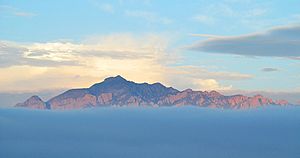Sky island facts for kids
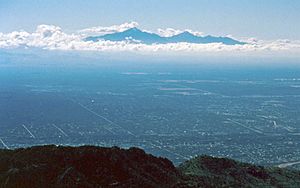
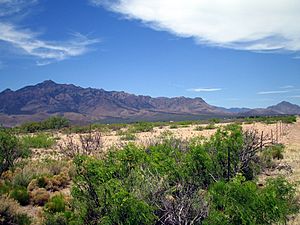
Imagine tall mountains that stand all alone, surrounded by flat, dry lands like deserts. These are called sky islands! They are like green, cool islands in a sea of hot, dry land. The name first described mountains near the borders of Arizona and New Mexico in the United States, and Chihuahua and Sonora in Mexico. Now, the term is used for similar isolated mountain forests all over the world.
These isolated mountains are very important for nature. About 20,000 to 10,000 years ago, the American Southwest started getting much warmer. This warming created huge deserts, which cut off these mountains from each other. Because they are so cut off, sky islands are home to special plants and animals. Some are found nowhere else! Animals might move up and down the mountain with the seasons, and some species are "leftovers" from a much colder time.
Scientists who study where living things are found (called biogeography) and how to protect them (called conservation biology) are very interested in sky islands. They want to understand how so many different kinds of plants and animals can live there. A key part of a sky island is that it's far from other mountains, making it a unique habitat surrounded by a very different environment.
Some sky islands are like safe havens for plants and animals that prefer cold weather. As the world got warmer after the last ice age, these species got "stuck" on the cool mountaintops. In other places, the plants and animals on sky islands can slowly change over time and become new species. This is similar to how new species formed on faraway islands in the ocean, like the Galápagos Islands.
Contents
How the Name "Sky Island" Started
The idea of "sky islands" began in 1943. A writer named Natt N. Dodge wrote an article in Arizona Highways magazine. He called the Chiricahua Mountains in Arizona a "mountain island in a desert sea."
Around the same time, people also used the term for high, unglaciated areas on top of the Sierra Nevada mountains in California.
A nature writer named Weldon Heald, who lived in Arizona, made the term famous. In his 1967 book, Sky Island, he showed what a sky island was like. He described a drive from the desert town of Rodeo, New Mexico, to a peak in the Chiricahua Mountains. This drive was about 56 kilometers (35 miles) long and went up 1,700 meters (5,600 feet) in elevation. As he drove, he went from a hot, dry desert to grasslands, then to oak and pine forests, and finally to spruce, fir, and aspen forests. His book also talked about the wildlife and how people lived in the Chiricahuas.
Scientists also started to think of mountains as islands of habitat. Famous writers like David Quammen and John McPhee have used this idea too. This concept is part of a bigger study called island biogeography. It's not just about mountains in the American Southwest; it can be used for mountains and highlands all over the world.
What Makes Sky Islands Special?
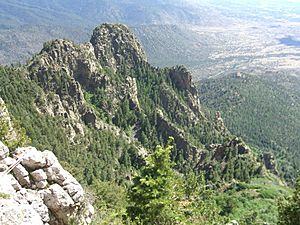
The Madrean Sky Islands are probably the most studied sky islands in the world. They are found in New Mexico and Arizona in the U.S., and Chihuahua and Sonora in Mexico. These many mountains form a chain connecting the northern Sierra Madre Occidental and the southern Colorado Plateau. In other parts of the United States, mountains surrounded by plains are sometimes called "island ranges," like the Wichita Mountains in Oklahoma.
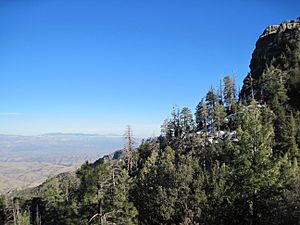
Some sky islands further north include the Crazy Mountains and Castle Mountains in Montana. These mountains have forests, and some even have tundra and snow above the tree line. But they are not connected to other mountains by forests; they are completely surrounded by treeless prairies or dry scrublands. Other well-known sky islands in North America are the Great Basin montane forests, like the White Mountains in California, and the Spring Mountains near Las Vegas.
One special thing about the sky islands near the U.S.-Mexico border is their mix of plants. The trees and plants at higher elevations are more like those found in colder, northern places. But the plants at lower elevations are like those found in the desert or mountains further south. Some unique plants and animals live in these sky islands, such as the mountain yucca, Mount Graham red squirrel, and Jemez Mountains salamander.
Some mountain species seem to have developed right where they are, adapting to their local environment. However, some isolated mountain ecosystems can lose species over time. This might happen because small groups of animals are more likely to become extinct. Also, because the habitat is so isolated, it's harder for new species to arrive.
Some animals, like the grizzly bear, need many different kinds of habitats. These bears used to live in the forests and meadows of the Madrean sky islands, as well as in lower areas near rivers. (Grizzly bears disappeared from this region in the 1900s.) Animals can also move between high and low habitats with the seasons. For example, the mountain quail in the Great Basin mountains lives in high places when there's no snow. Instead of flying south for winter, they fly down the mountain!
Sometimes, a group of sky islands, or even the valleys between them, can act as a path for animals to move, not just a barrier. For example, birds like the elegant trogon and mammals like the white-nosed coati have used the Madrean sky island chain to spread their ranges northward.
Sky Islands Around the World
Sky islands are found in many places across the globe. Here are some examples from different parts of the world:
Africa (Afrotropical realm)
- Cal Madow
- Ethiopian Highlands
- Mount Kilimanjaro
- Rwenzori Mountains
Australia and Oceania (Australasian realm)
- Mount Wilhelm
- Mount Taranaki
Asia (Indomalayan realm)
North America (Nearctic realm)
Central and South America (Neotropical realm)
- Baja California mountains
- Cordillera of Central America
- Tepuis (table-top mountains)
Europe and Asia (Palearctic realm)
- Aïr Mountains
- Altai Mountains
- Caucasus
- Tibesti Mountains
See also
 In Spanish: Islas serranas para niños
In Spanish: Islas serranas para niños


